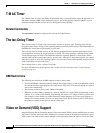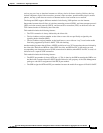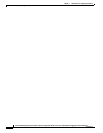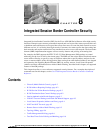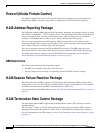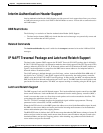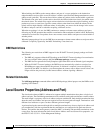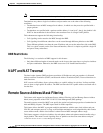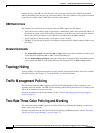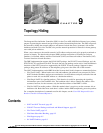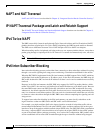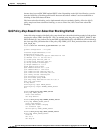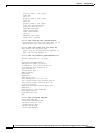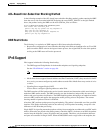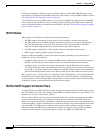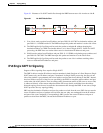
8-6
Cisco IOS XE Integrated Session Border Controller Configuration Guide for the Cisco ASR 1000 Series Aggregation Services Routers
OL-15421-01
Chapter 8 Integrated Session Border Controller Security
Topology Hiding
Packets arriving at the SBC are classified into flows using the following data: VPN ID, destination
address, destination port, protocol type, and source address. The source address is only required to match
a remote source address mask rather than a specific remote address.
DBE Restrictions
The following are restrictions of data border element (DBE) support for this feature:
• If the remote source address mask is specified for a termination, then it must contain the address in
the remote descriptor, unless NAT latching techniques are used. However if you want more than one
flow on the same local address or port, then the local address must be MGC-managed.
• A prefix length of 0 for the remote source address mask is invalid.
• The MGC is only allowed to specify local addresses and ports that lie within configured address and
port ranges.
Related Commands
• The media-address ipv4 command has dbe and mgc options that indicate whether an address pool
is provided from which the DBE or MGC can allocate addresses.
• The new media-address pool ipv4 command creates a pool of sequential IPv4 media addresses that
can be used by the DBE as local media addresses; the command also has dbe and mgc options.
Topology Hiding
Topology hiding is an important function of security because it protects the identity of the users and their
network addresses. See
Chapter 9, “Topology Hiding” for more information.
Traffic Management Policing
The data border element (DBE) supports the H.248 Traffic Management (Tman) package to police
signaling and media streams. The DBE can also monitor packets coming from the access (customer) side
and from the backbone (network core) side.
For more information on the Tman package, see the “H.248 Traffic Management Package Support”
section on page 5-1.
Two-Rate Three-Color Policing and Marking
The data border element (DBE) supports Two-Rate Three-Color Policing and Marking to control the
traffic coming from the user.
For more information on the Two-Rate Three-Color Policing and Marking feature, see the “Two-Rate
Three-Color Policing and Marking” section on page 5-5.



